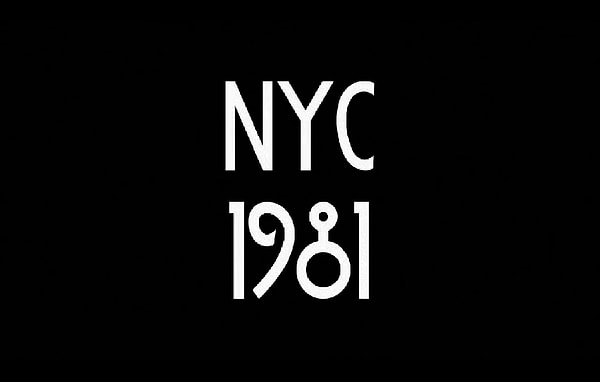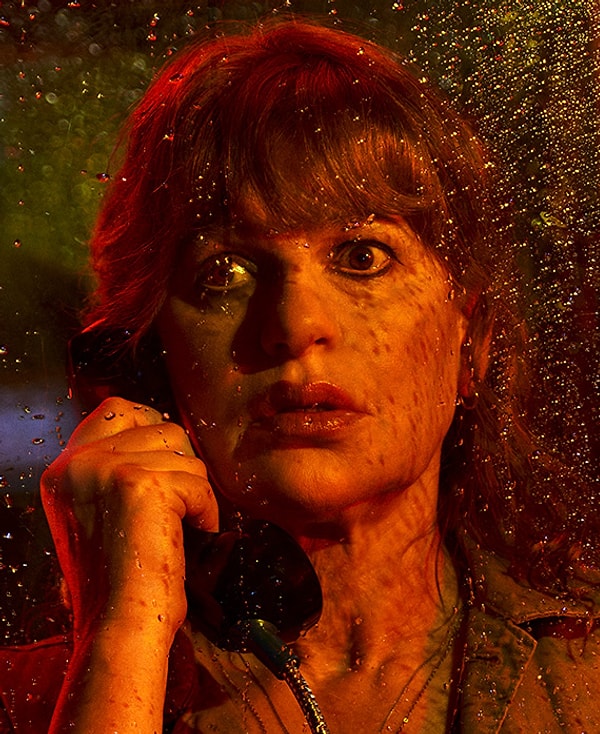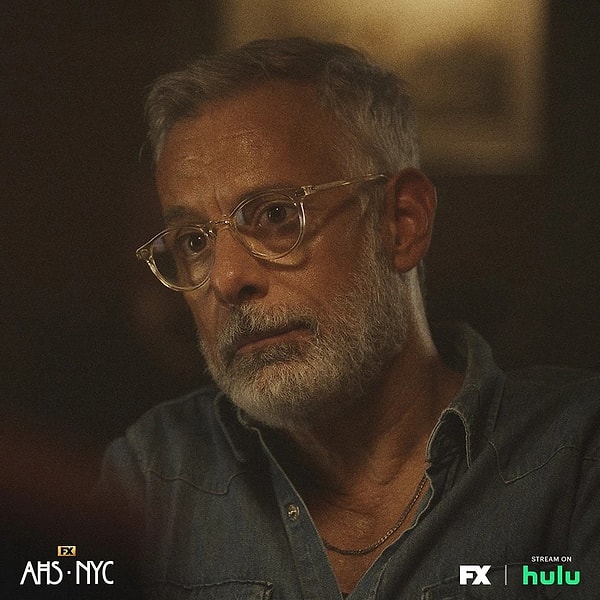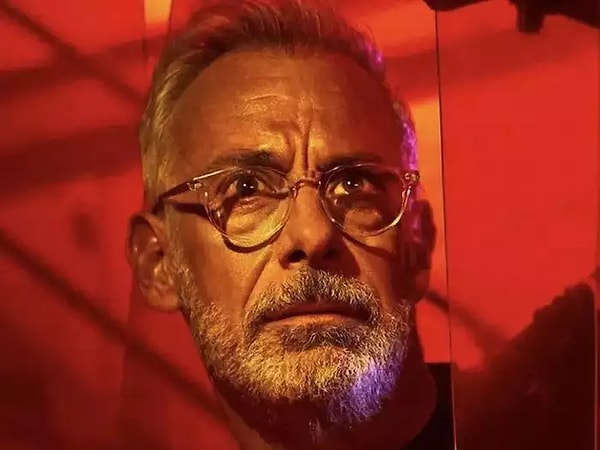Why Gino Barelli Matters in 'American Horror Story'
The bus ride from the West Campus to the downtown station usually took about ten minutes, give or take, depending upon how many times they had to stop to pick up passengers. The route traveled through a section of town called Barrio Hollywood, known for its tiny, low-income homes, its massive trailer parks, and its thriving population of street addicts. I barely noticed. I was young, zealous, and naive--immersing myself in what would eventually become a failed college career.
I would take a seat in front, pull my history book out of my oversized shoulder bag, and immerse myself in stories about the Indus River Valley and Mesopotamia, ignoring everyone that passed by. I was determined to memorize every tiny thing in that giant tome, every invention, and every name and date. I was going to prove myself, and make sure that everyone knew I was the best. But not that afternoon.
I noticed the man when he got on--his bright blue eyes, the kind you'd never want to make contact with. He was hairless except for a fuzzy patch of baby hair, and his skin was leathery--tanned like he'd been in the oven too long. He was covered in white splotches, almost like vitiligo or chemical burns. He got on the bus, sauntered up, smelling like rolled cigarettes and cheap weed, and slapped the book out of my hand. 'The fuck dude?' he shouted. 'You call my girl a d*ke?' He reached forward, grabbed me by the collar, and slammed me in the face--hard enough that one of the passengers in the back gasped. There was a lurch when the driver slammed on the brakes and yelled, 'Get the hell off!' He turned in the driver's direction, let me go, and started to walk out. 'Man, fuck this shit. I ever see you again, so help me.'

Courtesy of FX
I was left shaken and disturbed. There was no rhyme or reason to what had happened. Of course, I didn't know this creature. I had no idea who his girl was, and I certainly never called her gay. This was a random attack, but it was enough to get me scared. My town is small--roughly half a million people--and very few of us rode public transportation. Usually, the passengers were a different mix of the same group every afternoon. I fully expected to see my attacker again, and it frightened me. He could easily show up again and hurt me. He could have a knife or a gun, or he could simply beat me to a pulp. He looked strong. Nobody was going to stop him. The other passengers couldn't be expected to chime in, and the drivers rarely involved themselves in fights. I was unprotected and vulnerable.
I got off at my usual stop and made a quick beeline for the LGBTQ+ center, Wingspan, where I'd spend my afternoons typing out my homework in the computer lab. I knew that there were cameras on the bus, and I was pretty sure that they were used by the police department to regulate things. I thought that maybe if I filed a report they could ban him from the city buses. I just had to get ahold of a phone.
I was trembling when I got off, swimming from the sudden burst of desert sun. People had been staring at me like I was about to explode, whispering, and shifting around uncomfortably on the bus. I was glad to have a moment to walk it off, calm down, and get my bearings. They didn't have a public phone at Wingspan, but I figured I'd try my luck anyway. If I insisted that I wanted to file a police report and that I'd just been attacked, maybe they would give in and let me call.

Courtesy of FX
I was ready for a fight. I thought they might turn me away when I reached the front desk. But when I told the receptionist what had happened, she stood up, opened the partition between the desk and the lobby, and told me to follow her down the hall into a back room. There was no phone in there, and I said so--just an empty table. She shook her head in frustration. 'Why do you think this place is here? This center is funded by the anti-violence project.'
'I thought that was for people in abusive relationships,' I said, referring to the signs I'd seen in the restroom.
'It's for anyone who needs to speak to the police. We'll file the report and provide a liaison to oversee the process. That's what we do.' She went on to explain that the police had a long history of ignoring people in the community. So the community struck back by funding a team of lawyers to pressure them into following up on hate crimes. They even provided legal representation. I didn't consider myself a victim of a hate crime. I was sure the man recognized that I was gay. It was impossible not to notice. But that wasn't his motive for attacking me. He was just psycho. She asked if I wanted to proceed, and I said I would. I was intrigued by what she had said. I wanted to see how things worked, and I was deadset on getting him banned from public transportation.

Elvert Barnes / Flickr
The liaison reminded me of Annie Lennox. She was dressed in a black suit and tie, and she had an orange buzzcut with geek glasses. She was very professional. She took down notes, asking questions as I relayed my experience to her. She wanted to know if I was hurt and if I wanted to press charges. I wasn't really hurt just shaken, but if there was even a small chance I could have him sent to jail, I wanted to take it. When the police came, they didn't seem overtly homophobic. They were middle-aged men, skinny, and just as businesslike as the liaison. One had a mole above his lip, covered in hair. They said there was nothing they could do, even though the incident was caught on camera. It sucked, but everyone involved said that I probably wouldn't see the man again. I didn't feel discriminated against. I still don't believe that I was. They just didn't have a way to identify my attacker, not by name at least. When we were finished, I thanked everyone and left, feeling somewhat reassured.
Sometime later, I'm not sure how long, I saw the officer with the mole harassing a gay couple that kissed at the downtown station. When I intervened, he threatened to take me in for disorderly conduct, adding in a slur for good measure. He might not have been able to help me with my problem whether he wanted to or not, but the public did need to find ways to protect themselves from him. What I didn't realize was that there was a pervasive culture of discrimination in the department, accompanied by a healthy dose of corruption, complacency, aggression, and general laziness. It's come up time and time again over the years. Whenever someone I knew--or I myself--had to dial that magic number, they proved themselves to be a destructive force. It didn't show any signs of getting better until we instituted body cams and started prosecuting them for misconduct. Everyone, even people outside the community, could've benefited from a liaison. I had no idea how lucky we were to have them.
I later learned that there were centers like Wingspan all across the United States--one in Salt Lake, another in Boise, Portland, Oregon, Sacramento, San Francisco, San Diego, L.A., and of course New York--and those were just the ones I could name. They were part of a larger political issue that was being researched and documented by members of our rights movement. The police didn't listen. They didn't care. They ignored us, and they ignored a lot of other people too. They were able to get away with it--just like all of the other atrocities they got away with--because nobody held them accountable. If they decided someone was going to jail, they went, and the courts favored their testimony. If they decided that someone deserved a beatdown, they got one. If they decided not to enforce the law, nothing could stop them, and there would be no evidence to the contrary. I've seen many of these things--including beatings, intentional false arrests, and a refusal to enforce the law--myself over the years, and that's just from living a normal, law-abiding life. Everyone was subjected to their special brand of corruption, but members of the LGBTQ+ community and other minorities were especially vulnerable. Wingspan came armed with a mountain of research to back that up. That's how they were able to garnish funding. But nobody really needed proof of misconduct or prejudice--not unless they were sheltered or biased. It was common sense. That's why their message worked so well, and it's how they were able to build such an extensive network of liaisons and drop-in centers.

Courtesy of FX
The Magic of Gino
It's been said that fiction is an intricate lie, but when it comes to American Horror Story, there's also a little bit of truth mixed in. Ryan Murphy and Brad Falchuk take tiny tidbits of history--dropping names, adapting events, and symbolism--and they twist them to make them more entertaining. In Asylum, Anne Frank showed up to confront their version of Josef Mengele. Madame LaLaurie and Marie Laveau made an appearance in Coven. The Black Dahlia murders factored heavily into Murder House. Almost every season has a dash of history, even if it's unrecognizable.
Gino Barelli is a part of that tradition. His story started with the 1969 Stonewall Riots in New York City, which have been mistakenly credited with kicking off the gay rights movement. On June 28 and 29 of that year, the police raided a gay bar, Stonewall Inn, slaughtering and arresting members of the community. Rather than take it, the bar's patrons decided to fight back. They threw bottles and bricks. Punches went flying. They refused to leave. There was reportedly a group of transexuals that locked arms and did the canne canne, kicking cops as they sang. It was a night to be remembered, and it was all documented by journalist Arthur Bell, who was determined to fight for a better quality of life.
He wanted rights, dignity, and freedom for the greater LGBTQ+ community, and he worked with various groups to help make that happen. He even became a founding member of the Gay Activists Alliance, which empowered members of the movement, giving them the outlets, the organization, and the resources they needed to make their voices heard. This was a time of turmoil. Many people in the community had fled to New York from rural areas where they had little to no chance of finding work or housing--not with the pervasive prejudice, which still existed in the city. New Yorkers knew what was happening, and they didn't like it. Police would walk the streets, calling them names, and telling them to move along. They'd raid bars. The community had its havens, just like always. But the city was on a newly formed campaign to crack down on them, enforcing a dress code that required them to wear clothing that matched their birth sex. Even during that time, it was an uncharacteristically strict measure, and it's what led Stonewall patrons to fight back. As a result, tensions rose. There was even more brutality. People were violated, beaten, and killed. They were shot at, jumped, and thrown around endlessly. The city seemed to erupt. That's when protests started and people began to organize. Their main enemy was the NYPD.

Courtesy of FX
By the 70s, public sentiment was starting to change. The LGBTQ+ community was represented on television, on film, in music, and on stage. They appeared in episodes of Mary Tyler Moore, Maude, and All in the Family, where they were directly identified, and their issues were addressed. There's a long history of nightlife--clubs, speak-easies, dances, and bars--and there was a massive subculture, especially in New York, all visible and easily tracked. People think homosexuality somehow started in the mid-1900s. But everyone--whether it was 1860 or 1973--had a family member, a cousin, brother, or sister, who they could point to--often someone they grew up with who had been showing signs since they were young. It wasn't talked about. People denied it ad infinitum, but it was there, and if you knew where to look, it was thriving.
So when women started to gain rights, both in the home and the workplace, and people started to listen to what they had to say, gays were right there ready for their time in the limelight. It started to happen slowly, partially because of the progress made by the sexual revolution. They were given jobs and housing for the first time. The public was starting to shrug, taking on a live-and-let-live attitude. Things got better. But there was always an element of society that wasn't comfortable with it.
Some of them acted out. Punks and teenagers would wait outside bars, pick men up, and beat them. They'd be stabbed in alleyways, lured in with promises of sex, and murdered. There were gangs that would get together and pick them off one by one, spending their nights trolling Greenwich Village, a hub for the community.

Courtesy of FX
Things came to a header in 1975, when a trash bag filled with dismembered remains was found in the Hudson River. They called it the Bag Murders. This kept happening until 1977. Police were able to identify pieces of leather clothing that had been purchased from a shop in Greenwich Village, which catered to the leather culture within the community. It was assumed at that point that all of the men involved were gay.
At the time, NYPD was intentionally ignoring hate crimes against the community. This included much of the evidence against the Bag Murders killer. They would gaslight anyone that came in. They'd lose reports. They'd refuse to listen or act like they were going to help and then refuse to follow up. It was obvious that it was going on, and everyone knew why: prejudice.
While this was happening, Arthur Bell was running a column in the Village Voice called 'Bell Tells.' One of his friends, Addison Verrill, was killed, and it inspired him to start writing about the NYPD's behavior. He went over the killings and the disappearances, and he put a spotlight on everything that was happening in the city. He saw it as a larger issue. People in his community were being robbed of their voice, and they were being denied the protection that was freely given to other residents. They already had targets on their backs, and now they were being ignored. It wasn't safe.

Courtesy of Hulu
Gino Barelli's crusade against the NYPD is based directly on Arthur Bell. We see him printing the same types of articles that Bell wrote, addressing the complacency of the police department. Both Gino and Bell went on an extensive campaign, and Bell was also involved in apprehending a murderer. He received a phone call from someone who claimed to have killed his friend. The man went on about who he was, what had happened, and all of the things he had done. He just didn't leave a name.
Ironically enough, Arthur Bell was able to get the police to show up the next night. He believed that the man would call again, and even though he didn't, someone else did call and give them everything they needed to find the man who killed Arthur's friend. His name was Paul Bateson, and he's part of the basis for Whitely's character. They weren't able to connect him to the Bag Murders, which are addressed at the beginning of the series. But there were rumors that he was the culprit. Most of this doesn't transfer into the show's plot. They did use phone calls already. Whitely called Gino's boyfriend to warn him that he was going to hunt in Central Park. But that's not what happened in real life. That's Ryan Murphy and Brad Falchuk's style. They take little pieces of history here and there, and they warp them.
What was so amazing about Bell was the impact his journalism had on the LGBTQ+ community and the nature of activism going forward. He was able to appeal directly to the public, and they listened loud and clear. Nobody was about to deny the problem. Everyone knew there was anti-gay prejudice. They knew that it was leading to hate crimes, and it wasn't a stretch to say that the NYPD was refusing to help. Nobody was about to take a pro-violence stance. The general belief was that things needed to change. Bell also inspired rights activists to begin organizing to protect themselves. Ever since then, there have been members of the community providing liaisons--formally or informally--to help file police reports. They've also been reaching out to members of law enforcement, educating them, and trying to maintain a healthy relationship with them. When I was younger, bars would have squad cars waiting outside, and community activists would facilitate outreach groups at different precincts. All of this helped, but it was the liaisons that really mattered. Nobody could change the nature of the beast. We found ways to watch them, hold them accountable, and use the system against them when they acted against us. Had a single hate crime gone unreported in my city, there would've been reports to internal affairs, even lawsuits. Arthur Bell made sure that the police would never do that to us again, and Gino is an homage to his efforts.
Keşfet ile ziyaret ettiğin tüm kategorileri tek akışta gör!

Send Comment